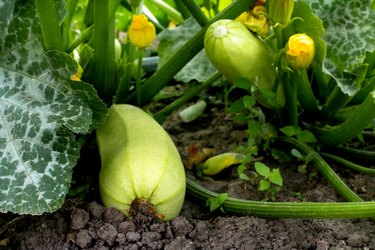
Zucchini (Cucurbita pepo) is a popular garden crop because it can grow in most climates as long as it's planted after the last frost of the winter has passed – and because it's tasty, nutritious and versatile. But you'll never get to taste chocolate bread or crispy fritters made with your homegrown zucchini if your plants are destroyed by insect damage. Small, striped black and yellow bugs are a common pest for zucchini plants, and these small striped bugs can be fatal to your crop.
Identifying Black and Yellow Bugs
Video of the Day
A striped black and yellow bug on a zucchini plant is most likely a cucumber beetle (Acalymma vittatum). These small, striped bugs are typically about 1/4 inch long. A closely related type of insect, the spotted cucumber beetle, may also be present on zucchini plants. They're similar in size and shape to striped cucumber beetles but have 12 black spots on their yellow wing covers.
Video of the Day
Cucumber beetles are often found on cucurbits, a plant family that includes squash, melons, cucumbers and zucchini.
The Dangers of Cucumber Beetles
When cucumber beetles find your zucchini plants, they might only cause minor damage, or they might completely destroy the plant. These insects feed on cucurbits at all points in a plant's life cycle. They'll chew through your newly planted zucchini seedlings and stunt their growth and chew holes through more mature plants too.
The biggest risk associated with cucumber beetles is bacterial wilt. Cucurbits are vulnerable to a particular type of bacteria that cucumber beetles can transmit from infected plants to your healthy zucchini plants. Once these pesky small, striped bugs feed on your zucchini and the bacteria moves into the plant's vascular system, the multiplying bacteria will cause the leaves to gradually wilt. The entire plant will inevitably die once bacterial wilt takes hold, so the only way to protect your zucchini crop is to discourage cucumber beetle activity.
Pest Control for Zucchini Bugs
Use a multipronged approach to keep zucchini bugs away from your plants without introducing dangerous pesticides into your edible vegetable garden. Protect young zucchini plants with floating row covers to keep out insects but remove the covers when the plants begin to flower so bees and other pollinators can get to them. Be diligent about removing weeds and fallen leaves from your garden since they give beetles shelter.
Maintain a heavy layer of mulch around the base of each zucchini plant throughout the summer. Surrounding the plant with a loose material, like straw mulch, makes it challenging for beetles to move from plant to plant. If you have a significant cucumber beetle infestation, you may decide to treat the plants with an organic pesticide that's safe for use on edible crops. Neem oil and pyrethrin are two pesticides that may be used safely in your vegetable garden provided you read and follow package instructions very carefully.
Unfortunately, by the time you spot black and yellow zucchini bugs on your plants, it's too late in the season for some preventative measures, such as trap crops. Next year, plant crops that are highly attractive to cucumber beetles along the edge of your garden. Time the planting so these crops are emerging before your zucchini plants so the beetles will focus their activity on the trap crops. You can then destroy the plant either by digging it up or by treating it with pesticides and eliminate a lot of the cucumber beetles in your yard in one fell swoop.
- University of Minnesota Extension: Cucumber Beetles in Home Gardens
- University of Wisconsin-Madison Horticulture: Cucumber Beetles
- University of Kentucky Entomology: Cucumber Beetles
- South Dakota State University Extension: Managing Cucumber Beetles
- University of Florida Entomology and Nematology Department: Striped Cucumber Beetle